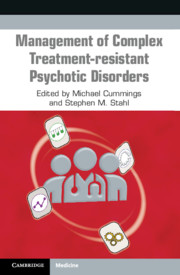Book contents
- Management of Complex Treatment-Resistant Psychotic Disorders
- Management of Complex Treatment-Resistant Psychotic Disorders
- Copyright page
- Contents
- Contributors
- Acknowledgements
- Abbreviations
- List of Icons
- Introduction
- Part I Treatment Strategies
- 1.01 Approaches to Positive Psychotic Symptoms
- 1.02 Use of Plasma Levels in Antipsychotic and Mood Stabilizer Treatment
- 1.03 Advantages of Long-Acting Injectable Antipsychotics
- 1.04 Approach to Treatment-Resistant Schizophrenia Spectrum Patients
- 1.05 Approach to Depressed or Suicidal Schizophrenia Spectrum Patients
- 1.06 Approach to Persistent Aggression and Violence in Schizophrenia Spectrum Psychotic Disorders
- 1.07 Approach to Bipolar Diathesis in Schizophrenia Spectrum Patients
- 1.08 Approach to Anxiety in Schizophrenia Spectrum Patients
- 1.09 Approach to Insomnia and Sleep Disturbance in Schizophrenia Spectrum Disorders
- 1.10 Approach to Psychosis in Children and Adolescents
- 1.11 Electroconvulsive Therapy and Other Non-Pharmacological Treatments
- 1.12 Approach to Substance Use Disorders in Schizophrenia Spectrum Disorders
- 1.13 Approaches to Behavioral Disturbances in Dementia and Traumatic Brain Injury Patients
- Part II Medication Reference Tables
- Appendices
- Index
- References
1.04 - Approach to Treatment-Resistant Schizophrenia Spectrum Patients
from Part I - Treatment Strategies
Published online by Cambridge University Press: 19 October 2021
- Management of Complex Treatment-Resistant Psychotic Disorders
- Management of Complex Treatment-Resistant Psychotic Disorders
- Copyright page
- Contents
- Contributors
- Acknowledgements
- Abbreviations
- List of Icons
- Introduction
- Part I Treatment Strategies
- 1.01 Approaches to Positive Psychotic Symptoms
- 1.02 Use of Plasma Levels in Antipsychotic and Mood Stabilizer Treatment
- 1.03 Advantages of Long-Acting Injectable Antipsychotics
- 1.04 Approach to Treatment-Resistant Schizophrenia Spectrum Patients
- 1.05 Approach to Depressed or Suicidal Schizophrenia Spectrum Patients
- 1.06 Approach to Persistent Aggression and Violence in Schizophrenia Spectrum Psychotic Disorders
- 1.07 Approach to Bipolar Diathesis in Schizophrenia Spectrum Patients
- 1.08 Approach to Anxiety in Schizophrenia Spectrum Patients
- 1.09 Approach to Insomnia and Sleep Disturbance in Schizophrenia Spectrum Disorders
- 1.10 Approach to Psychosis in Children and Adolescents
- 1.11 Electroconvulsive Therapy and Other Non-Pharmacological Treatments
- 1.12 Approach to Substance Use Disorders in Schizophrenia Spectrum Disorders
- 1.13 Approaches to Behavioral Disturbances in Dementia and Traumatic Brain Injury Patients
- Part II Medication Reference Tables
- Appendices
- Index
- References
Summary
Inadequate treatment contributes not only to poor quality of life but also to an increase in disease-related societal burdens. A small subset (20–30%) of the schizophrenia patient population are treatment-resistant and financially cost approximately ten-fold more than non-treatment-resistant schizophrenia patients [1]. Numerous ineffective antipsychotic trials continue to be prescribed while clozapine, which has widespread compelling efficacy data, continues to be underutilized in treatment-resistant schizophrenia. This chapter addresses clozapine efficacy in not only treatment-resistant psychosis but also comorbid suicidality and aggression, as well as treatment-resistant mania. Further, initiation and maintenance of clozapine treatment is summarized.
- Type
- Chapter
- Information
- Publisher: Cambridge University PressPrint publication year: 2021



